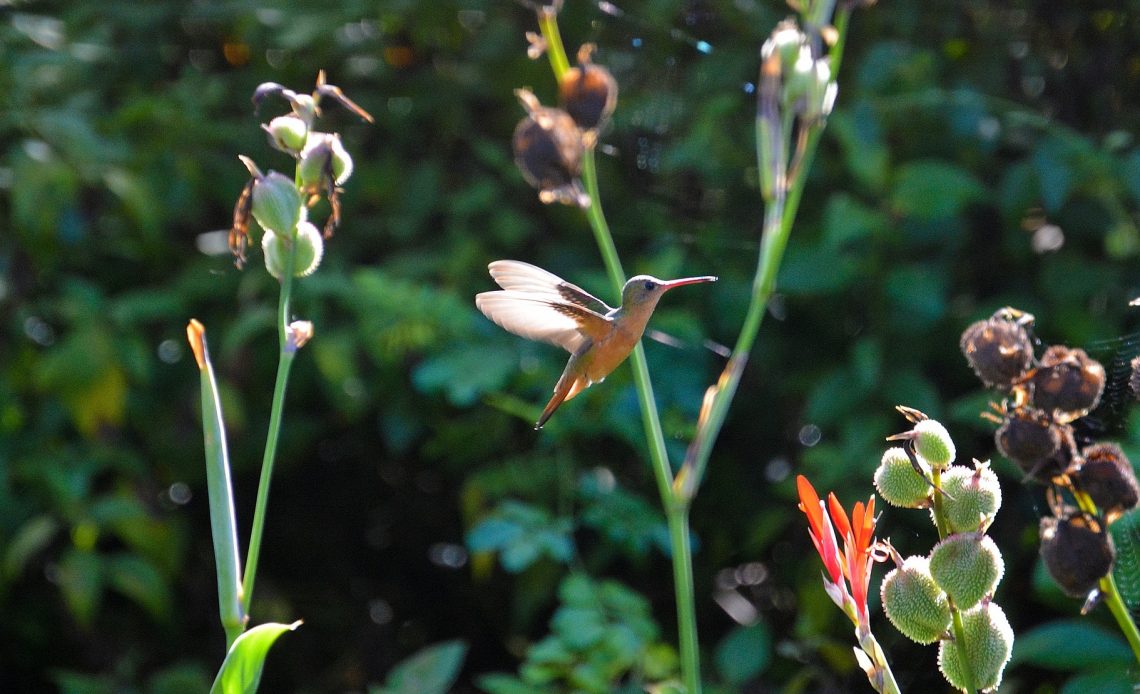

We’re here to help! Wild Yards is a completely free website that is 100% dedicated to helping you create a wildlife-friendly, sustainable yard. Read more
WildYards is reader-supported. When you buy a product through a link on our site, we may earn a comission. Every product is independently selected by our (obsessive) editors and our reviews are unbiased and objective. Read more about our mission or our privacy policy.
Hummingbirds, while famously voracious, are known to possess some ‘refined’ tastes. For example, they have a particular taste in flowers and fruit – and they’ll even snap insects out of the air. But do hummingbirds eat seeds?
Hummingbirds don’t eat seeds. Research and evidence suggest they simply don’t have the ‘tools’ to eat or digest them properly! Hummingbirds have evolved to mostly feed on sugar and insects.
Why don’t hummingbirds eat seeds?
Hummingbirds are interesting specimens in that, while they have beaks, they can’t peck. Other birds, such as chickens and woodpeckers, have powerful bills that can drill and crack. The hummingbird’s bill is long, thin, and fairly flimsy by comparison, making it near impossible for them to eat seeds, nuts, and other hard-shelled food.
Hummingbird beaks and tongues typically serve to probe and drink, not to crack and crunch. While it’s unclear whether or not hummingbirds will appreciate the taste of seeds, they have simply evolved to seek out more accessible food, such as liquid nectar from the insides of tube-shaped flowers.
Intriguingly, there’s further evidence of this in their digestive systems. They don’t possess a powerful enough metabolism to process seeds efficiently. The hummingbird’s metabolism requires it to eat more than three times its own body mass each day. It requires food that’s lightning-quick to digest and derive energy from.
These pollinators also need a source of protein. Hummingbirds will eat ants, flies, bugs, mosquitoes, and aphids – which are easily digested with one quick gulp. You’ll never see a hummingbird crunch or chew. In fact, it’s rare you will see a hummer open its beak at all!
The hummingbird won’t just avoid seeds – you can’t expect it to feed on pellets, pulses, grains, or nuts for the same reasons listed. That even includes the tooth-billed hummingbird, which, despite its name and evolutionary state, still won’t give your seed supply any interest.
Why do hummingbirds peck seeds at my feeder?
If you notice hummingbirds pecking at or showing interest in seeds scattered around your feeding station, there’s a good chance it’s found a bug or insect in the pile. There are no other reasons for hummers to feed on seeds – even if facing a state of torpor, they will hunt for flowers and bugs elsewhere before trying to peck.
It’s recommended you fill hummingbird feeders with sugary, soft treats – and even homemade nectar – in place of seeds or nuts. If you are feeding other birds in your garden, it’s even recommended you set up a separate table with seeds and other hard feed – as hummingbirds will bully their way into any feeding zone, regardless of what’s available to them. They are famously opportunistic and don’t give much thought to who gets in the way!
If you want to fill a hummingbird feeder, concentrate on soft fruit such as oranges, pears, or a little banana. They will also dip into watermelon and apple, too. Always make sure that any food you provide for hummingbirds (and any other wild visitor) is free from spices, artificial flavors and colors – as they can make your pollinators sick.
What do hummingbirds eat instead of seeds?
While other birds enjoy your feeder seed, hummingbirds are more likely to roam around your garden, feeding on nectar deep from inside bold, colorful flowers. They’ll also eat any winged insects and bugs that head their way, for a quick hit of protein and an extra energy top-up while hovering around.
To provide hummingbirds with the calories they need to keep fluttering around your yard, make sure to focus on growing their favorite flowers. These include azaleas, sunflowers, zinnias, fuchsias, impatiens, and dipladenias. To attract hummingbirds to your garden, avoid leaving out seeds and grains – choose plants that grow red, pink, and orange blooms, preferably in tube or trumpet shapes. These flowers are easiest for hummingbirds to dip into and feed on.
Brightly-colored and sweet-smelling flowers will also attract various insects and bugs, which hummingbirds will happily take care of for you.
While it seems reasonable to expect hummingbirds to eat seeds, they simply can’t – even if they want to! If you see a hummingbird at your feeder that’s beak-deep into seed, it’s likely found a gnat or insect morsel that’s far more interesting – and much easier to digest.
